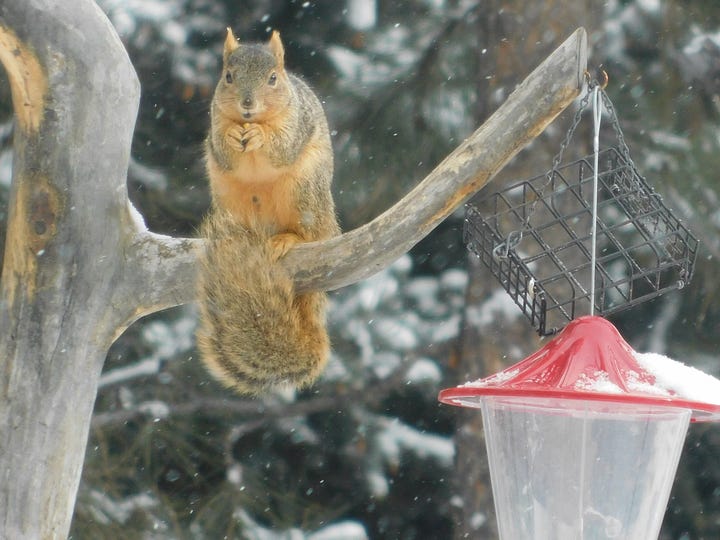Previously published in Oct 2022. That tail-talk never gets old.
It wasn’t a squirrel chatter or scold that got my attention. It was the flash of a perfectly geometric, dandelion-floof style, red tail with its symmetrical dark lines and mixed colors. Swishing in circles, down, up, back to a circle, left, right, back to a circle. Staring straight at me, this squirrel had something to say, and I was just too stupid to understand it. He repeated the tail-swish pattern, staring at me, “you idiot, don’t you understand what I’m trying to tell you? Here, I’ll say it again.” Swish, circle, straight out, curl over the back, back to circles, the mix of stripes and colors adding to the message conveyed. Surely, I should understand by now.
Intermixed with our little gray Pine squirrels and black or gray/white Abert squirrels is a third squirrel variation - the Fox Squirrel. The biggest of the squirrels here, up to 2.5lbs, and their bright coloring of yellow, to reddish, to orange, makes them stand out. They are not as constantly hyper as the Pine squirrels with their relentless, territory-protecting, pinecone-gathering ways. Nor are they as goofy with parkour antics with their buddies like the Abert squirrels. Fox squirrels are somewhat more solitary, yet convey their messages to their fellow Fox squirrels via scent marking and the tail semaphore dance.
Researchers have been trying to decode the Fox squirrel’s ‘tail-talk’ and have mainly noticed conveyances of frustration at getting to a food source, and a warning of potential dangers. My local Fox squirrel had no look of frustration, nor warning, as he stared at me stock still, but with his wild tail movements. I’d like to think he was telling me a story.
For an animal that finds itself near the bottom of the food chain, brilliant intelligence lies just below the surface. The frustration at encountering an obstacle to a food source soon leads to sophisticated, creative, and sometimes heroic solutions for the ‘squirrel-proof bird feeder’ to be conquered. Perhaps his ‘tail-story’ is a recount of his mastery of the bird feeder.
Being near the bottom of the food chain, eventually, lead to his survival as a species. The Fox squirrel is not native to the Western United States. The theory goes that after the Civil War, with Westward expansion, many people brought the Fox squirrel with them as they migrated to Colorado, Utah, California, and other western states. For some, the squirrels were beloved pets, which was very popular in the mid-1800s. For others, the beefy-sized squirrel made for good eating, and with 2 broods a summer, there would be some guaranteed supper when heading into unknown lands.
The Fox squirrels thrived in our open forests and urban areas, preferring sites close to water sources of creeks, ponds, and wetlands such as we have here. They can adapt to quite a variety of foods from the classic nuts, to fruits, insects, seeds, bird eggs, corn, soybeans, oats, and wheat. Human leavings are appealing also and they don’t mind our messy food habits. As with their other squirrel cousins, the Fox squirrel buries nuts and seeds for later consumption only to be forgotten, which will sprout into new trees and plants. They like to look at it as ‘squirrel forestry management’, thank you very much.


They adapted so well to their new lands that they settled in and often make both summer and winter homes. A summer house is called a ‘drey’, it is an intricate construction of twigs and leaves, interlocking to make a hollow, basketball-sized, center with leaves and pine needles worked in to create a rainproof nest. The ‘ball’ will likely have both a front door and a back door to escape predators. The nesting area will be filled with soft materials, feathers, fur, and other cushy finds. Some of these well-made dreys can last many generations of squirrel habitation. It takes constant upkeep and additions to last. Most dreys last only that season, though; storms, predators, fleas, lice, and poor construction will all lead to the demise of the summer home.
A winter home is a tree cavity that has been hollowed out by woodpeckers, as mentioned in my previous post on snags. These cavities can better handle the storms, winds, freezing temperatures, and snow that accompany the first brood of late winter, and early spring. Combined family body heat is better contained in a snug wooden cavity filled with downy feathers, clumps of dog fur and other soft nesting fluff. This is a tighter fit, though, often without escape routes. Trade-offs are made with each home style. And the squirrels survive. Since it takes up to four months for squirrel pups to mature, some squirrel families stick together right through their first winter, supporting each other, teaching, and communicating.
So, maybe Mr. Fox squirrel was bragging about his fancy summer drey or telling the story of conquering the bird feeder, or perhaps it was a far more complex notion of comparing squirrel and human conditions, or a story of families and travels, dangers and successes. Yes, I’d like to think he was telling me much more than a demand to fill the peanut ring. Perhaps someday, I just might understand.
Sources:
- Fox squirrel. (2022, October 4). In Wikipedia. https://en.wikipedia.org/wiki/Fox_squirrel




